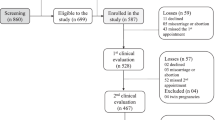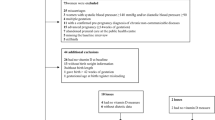Abstract
Background/Objectives:
Observational studies relating 25-hydroxyvitamin D (25(OH)D) and pregnancy outcomes have reported conflicting results. The aim was to assess maternal 25(OH)D status and its association with pregnancy outcomes. A prospective observational study was carried out in Guangzhou city (23 ºN), China.
Subjects/Methods:
Pregnant women (n=2960) and healthy controls (n=100) were recruited at a teaching hospital. Maternal 25(OH)D levels were measured at 16–20-week gestation. The pregnant women, if met inclusion and exclusion criteria, were enrolled in further analysis for pregnancy outcomes (n=1953).
Results:
Mean serum 25(OH)D in pregnant women was 27.03±7.92 ng/ml. In total, 18.9 and 48.6% of pregnant women had low (25(OH)D less than or equal to 20 ng/ml) and medium level (25(OH)D 21–29 ng/ml) of vitamin D, respectively. 25(OH)D was highest in summer and lowest in winter, which showed a positive correlation with temperature (R=0.942) and calcium (R=0.074). Most maternal outcomes (premature rupture of membranes break, polyhydramnios, oligohydramnios, pre-eclampsia, cesarean section), fetal outcomes (spontaneous abortions, medically induced labor, fetal death, fetal distress, fetal growth restriction) and neonatal outcomes (malformations, birth weight and height, low birth weight, macrosomia, small-for-gestational age, score of Apgar 1′,5′, asphyxia of newborn) were not significantly different between groups, but prevalence of gestational diabetes (adjusted odds ratio (OR) 1.017; 95% confidence interval (CI) 1.002–1.033) and preterm delivery (adjusted OR 1.038; 95% CI 1.018–1.059) in high level group (25(OH)D ⩾30 ng/ml) was higher than that in low and medium level groups.
Conclusions:
The prevalence of low level of vitamin D (serum 25OHD ⩽20 ng/ml) was 18.9% among pregnant women in southern China. There were no significant differences in most adverse pregnancy outcomes among pregnant women with different levels of vitamin D at 16–20-week gestation except for higher prevalence of gestational diabetes and preterm delivery in women with high level of vitamin D, possibly related to the older age and higher body mass index of this group.
This is a preview of subscription content, access via your institution
Access options
Subscribe to this journal
Receive 12 print issues and online access
$259.00 per year
only $21.58 per issue
Buy this article
- Purchase on Springer Link
- Instant access to full article PDF
Prices may be subject to local taxes which are calculated during checkout

Similar content being viewed by others
References
Hogan MC, Foreman KJ, Naghavi M, Ahn SY, Wang M, Makela SM et al. Maternal mortality for 181 countries, 1980-2008: a systematic analysis of progress towards Millennium Development Goal 5. Lancet 2010; 375: 1609–1623.
Filippi V, Ronsmans C, Campbell OM, Graham WJ, Mills A, Borghi J et al. Maternal health in poor countries: the broader context and a call for action. Lancet 2006; 368: 1535–1541.
Sahu M, Bhatia V, Aggarwal A, Rawat V, Saxena P, Pandey A et al. Vitamin D deficiency in rural girls and pregnant women despite abundant sunshine in northern India. Clin Endocrinol (Oxf) 2009; 70: 680–684.
Bodnar LM, Simhan HN, Powers RW, Frank MP, Cooperstein E, Roberts JM . High prevalence of vitamin D insufficiency in black and white pregnant women residing in the northern United States and their neonates. J Nutr 2007; 137: 447–452.
Thandrayen K, Pettifor JM . Maternal vitamin D status: implications for the development of infantile nutritional rickets. Endocrinol Metab Clin North Am 2010; 39: 303–320. table of contents.
Bischoff-Ferrari HA, Giovannucci E, Willett WC, Dietrich T, Dawson-Hughes B . Estimation of optimal serum concentrations of 25-hydroxyvitamin D for multiple health outcomes. Am J Clin Nutr 2006; 84: 18–28.
Holick MF . High prevalence of vitamin D inadequacy and implications for health. Mayo Clin Proc 2006; 81: 353–373.
Parlea L, Bromberg IL, Feig DS, Vieth R, Merman E, Lipscombe LL . Association between serum 25-hydroxyvitamin D in early pregnancy and risk of gestational diabetes mellitus. Diabet Med 2012; 29: e25–e32.
Baker AM, Haeri S, Camargo CA Jr, Espinola JA, Stuebe AM . A nested case-control study of midgestation vitamin D deficiency and risk of severe preeclampsia. J Clin Endocrinol Metab 2010; 95: 5105–5109.
Shibata M, Suzuki A, Sekiya T, Sekiguchi S, Asano S, Udagawa Y et al. High prevalence of hypovitaminosis D in pregnant Japanese women with threatened premature delivery. J Bone Miner Metab 2011; 29: 615–620.
Merewood A, Mehta SD, Chen TC, Bauchner H, Holick MF . Association between vitamin D deficiency and primary cesarean section. J Clin Endocrinol Metab 2009; 94: 940–945.
Gernand AD, Simhan HN, Klebanoff MA, Bodnar LM . Maternal serum 25-hydroxyvitamin D and measures of newborn and placental weight in a U.S. Multicenter Cohort Study. J Clin Endocrinol Metab 2013; 98: 398–404.
Thorp J, Camargo C, McGee P, Harper M, Klebanoff M, Sorokin Y et al. Vitamin D status and recurrent preterm birth: a nested case-control study in high-risk women. BJOG 2012; 119: 1617–1623.
Charatcharoenwitthaya N, Nanthakomon T, Somprasit C, Chanthasenanont A, Chailurkit LO, Pattaraarchachai J et al. Maternal vitamin D status, its associated factors and the course of pregnancy in Thai women. Clin Endocrinol (Oxf) 2013; 78: 126–133.
Brunvand L, Shah SS, Bergstrom S, Haug E . Vitamin D deficiency in pregnancy is not associated with obstructed labor. A study among Pakistani women in Karachi. Acta Obstet Gynecol Scand 1998; 77: 303–306.
Yu CK, Ertl R, Skyfta E, Akolekar R, Nicolaides KH . Maternal serum vitamin D levels at 11-13 weeks of gestation in preeclampsia. J Hum Hypertens 2012; 27: 115–118.
Farrant HJ, Krishnaveni GV, Hill JC, Boucher BJ, Fisher DJ, Noonan K et al. Vitamin D insufficiency is common in Indian mothers but is not associated with gestational diabetes or variation in newborn size. Eur J Clin Nutr 2009; 63: 646–652.
Thorne-Lyman A, Fawzi WW . Vitamin D during pregnancy and maternal, neonatal and infant health outcomes: a systematic review and meta-analysis. Paediatr Perinat Epidemiol 2012; 26 (Suppl 1): 75–90.
Holick MF . Vitamin D deficiency. N Engl J Med 2007; 357: 266–281.
Dawson-Hughes B, Heaney RP, Holick MF, Lips P, Meunier PJ, Vieth R . Estimates of optimal vitamin D status. Osteoporos Int 2005; 16: 713–716.
Emmen JM, Wielders JP, Boer AK, van den Ouweland JM, Vader HL . The new Roche Vitamin D total assay: fit for its purpose? Clin Chem Lab Med 2012; 1–4.
Tao M, Shao H, Gu J, Zhen Z . Vitamin D status of pregnant women in Shanghai, China. J Matern Fetal Neonatal Med 2012; 25: 237–239.
Wang J, Yang F, Mao M, Liu DH, Yang HM, Yang SF . High prevalence of vitamin D and calcium deficiency among pregnant women and their newborns in Chengdu, China. World J Pediatr 2010; 6: 265–267.
Bowyer L, Catling-Paull C, Diamond T, Homer C, Davis G, Craig ME . Vitamin D, PTH and calcium levels in pregnant women and their neonates. Clin Endocrinol (Oxf) 2009; 70: 372–377.
Marwaha RK, Tandon N, Chopra S, Agarwal N, Garg MK, Sharma B et al. Vitamin D status in pregnant Indian women across trimesters and different seasons and its correlation with neonatal serum 25-hydroxyvitamin D levels. Br J Nutr 2011; 106: 1383–1389.
Aghajafari F, Nagulesapillai T, Ronksley PE, Tough SC, O'Beirne M, Rabi DM . Association between maternal serum 25-hydroxyvitamin D level and pregnancy and neonatal outcomes: systematic review and meta-analysis of observational studies. BMJ 2013; 346: f1169.
Draznin B, Sussman KE, Eckel RH, Kao M, Yost T, Sherman NA . Possible role of cytosolic free calcium concentrations in mediating insulin resistance of obesity and hyperinsulinemia. J Clin Invest 1988; 82: 1848–1852.
Morley R, Carlin JB, Pasco JA, Wark JD . Maternal 25-hydroxyvitamin D and parathyroid hormone concentrations and offspring birth size. J Clin Endocrinol Metab 2006; 91: 906–912.
Zhu K, Whitehouse AJ, Hart P, Kusel M, Mountain J, Lye S et al. Maternal vitamin D status during pregnancy and bone mass in offspring at 20 years of age: a prospective cohort study. J Bone Miner Res 2013; 29: 1088–1095.
Whitehouse AJ, Holt BJ, Serralha M, Holt PG, Kusel MM, Hart PH . Maternal serum vitamin D levels during pregnancy and offspring neurocognitive development. Pediatrics 2012; 129: 485–493.
Author information
Authors and Affiliations
Corresponding authors
Ethics declarations
Competing interests
The authors declare no conflict of interest.
Additional information
Author Contributions
JZ performed experiments, analysed data and wrote the paper. LS searched literature, analysed data and wrote the paper. JZ and LS contributed equally to this work. ML was involved in performing the 25(OH)D measurements. YL and XC interpretated data. ZW was involved in patient care and data collection. HX designed the study and wrote the paper.
Rights and permissions
About this article
Cite this article
Zhou, J., Su, L., Liu, M. et al. Associations between 25-hydroxyvitamin D levels and pregnancy outcomes: a prospective observational study in southern China. Eur J Clin Nutr 68, 925–930 (2014). https://doi.org/10.1038/ejcn.2014.99
Received:
Revised:
Accepted:
Published:
Issue Date:
DOI: https://doi.org/10.1038/ejcn.2014.99
This article is cited by
-
Effect of maternal vitamin D status on risk of adverse birth outcomes: a systematic review and dose–response meta-analysis of observational studies
European Journal of Nutrition (2022)
-
Relationship between maternal vitamin D status in the first trimester of pregnancy and maternal and neonatal outcomes: a retrospective single center study
BMC Pediatrics (2021)
-
Vitamin D status and vitamin D deficiency risk factors among pregnancy of Shanghai in China
BMC Pregnancy and Childbirth (2021)
-
Vitamin D during pregnancy and its association with birth outcomes: a Brazilian cohort study
European Journal of Clinical Nutrition (2021)
-
Early pregnancy vitamin D and the risk of adverse maternal and infant outcomes: a retrospective cohort study
BMC Pregnancy and Childbirth (2020)



